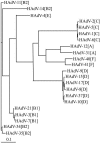Detection of antibodies against adenovirus protein IX, fiber, and hexon in human sera by immunoblot assay
- PMID: 16145087
- PMCID: PMC1234141
- DOI: 10.1128/JCM.43.9.4426-4433.2005
Detection of antibodies against adenovirus protein IX, fiber, and hexon in human sera by immunoblot assay
Abstract
The 51 serotypes of human adenoviruses (HAdVs) of the genus Mastadenovirus are classified into the six species HAdV-A to HAdV-F. For the detection of genus- and species-specific antibodies in human sera an immunoblot assay was developed. The recombinant long fiber of HAdV-41[F] (Ad41Fi) and the native hexon of HAdV-5[C] were used as genus-specific antigens. The recombinant capsid protein IX (pIX) of HAdV-2 (Ad2pIX[C]) and HAdV-41 (Ad41pIX[F]), the C-terminal pIX part of HAdV-3 (Ad3pIXC[B]), and the fiber knob of HAdV-8 (Ad8FiKn[D]) were evaluated as representative species-specific antigens. Hence, the pIX amino acid sequences of numerous serotypes of all HAdV species were compared, and the cross-reactivities of pIX antigens with rabbit hyperimmune sera among HAdV-A to -F were analyzed. In an epidemiological study, 667 human patient sera, not selected for viral infection, were screened for adenovirus seroprevalence. The genus-specific antibody prevalences directed against the Ad41Fi and HAdV-5 hexon were 82.8 and 98.8%, respectively. The species-specific antibody prevalence of 44.7% against Ad2pIX[C], 36.6% against Ad41pIX[F], 26.4% against Ad8FiKn[D], and 18% against Ad3pIXC[B] showed an age-dependent distribution and correlated well with the frequency of isolated serotypes of the respective species in earlier studies (except HAdV-D). In conclusion, the immunoblot assay using pIX, fiber, and hexon antigens represents a valuable and new serological tool for refined adenovirus diagnosis as shown in an epidemiological study.
Figures





Similar articles
-
Epitope mapping and cross-reactivity analysis of the monoclonal antibodies against hexon protein of human adenovirus type 3.Virus Res. 2009 Dec;146(1-2):58-65. doi: 10.1016/j.virusres.2009.08.011. Epub 2009 Sep 2. Virus Res. 2009. PMID: 19732803
-
Detection and sequence-based typing of human adenoviruses using sensitive universal primer sets for the hexon gene.Arch Virol. 2007 Jan;152(1):1-9. doi: 10.1007/s00705-006-0842-8. Epub 2006 Sep 8. Arch Virol. 2007. PMID: 16957827
-
Human adenoviruses in respiratory infections: sequencing of the hexon hypervariable region reveals high sequence variability.J Clin Virol. 2010 Apr;47(4):366-71. doi: 10.1016/j.jcv.2010.01.005. Epub 2010 Feb 10. J Clin Virol. 2010. PMID: 20149723
-
Human adenovirus type 8: the major agent of epidemic keratoconjunctivitis (EKC).J Clin Virol. 2014 Dec;61(4):477-86. doi: 10.1016/j.jcv.2014.10.015. Epub 2014 Nov 4. J Clin Virol. 2014. PMID: 25464969 Review.
-
Characterization of the main protein components of adenovirus virion and its possible use in laboratory diagnostics.Acta Microbiol Immunol Hung. 1998;45(3-4):281-3. Acta Microbiol Immunol Hung. 1998. PMID: 9873932 Review. No abstract available.
Cited by
-
Small-size recombinant adenoviral hexon protein fragments for the production of virus-type specific antibodies.Virol J. 2017 Aug 18;14(1):158. doi: 10.1186/s12985-017-0822-5. Virol J. 2017. PMID: 28821267 Free PMC article.
-
The conundrum between immunological memory to adenovirus and their use as vectors in clinical gene therapy.Mol Biotechnol. 2006 Oct;34(2):247-56. doi: 10.1385/MB:34:2:247. Mol Biotechnol. 2006. PMID: 17172670 Review.
-
Nonhuman Primate Adenoviruses of the Human Adenovirus B Species Are Potent and Broadly Acting Oncolytic Vector Candidates.Hum Gene Ther. 2022 Mar;33(5-6):275-289. doi: 10.1089/hum.2021.216. Hum Gene Ther. 2022. PMID: 34861769 Free PMC article.
-
Identification of a nonstructural DNA-binding protein (DBP) as an antigen with diagnostic potential for human adenovirus.PLoS One. 2013;8(3):e56708. doi: 10.1371/journal.pone.0056708. Epub 2013 Mar 13. PLoS One. 2013. PMID: 23516396 Free PMC article.
-
The prevalence of IgG and IgA against adenoviruses in serum of children aged 11-26 months, hospitalised in the Clinical Paediatric Hospital in Warsaw, Poland.Cent Eur J Immunol. 2014;39(1):91-5. doi: 10.5114/ceji.2014.42131. Epub 2014 Apr 17. Cent Eur J Immunol. 2014. PMID: 26155106 Free PMC article.
References
-
- Akalu, A. 1997. Antigenic characterization and posttranslational analysis of the protein IX of human adenovirus serotypes 2 and 3. Ph.D. thesis. University of Greifswald, Greifswald, Germany. (In German.)
-
- Akalu, A., W. Seidel, H. Liebermann, U. Bauer, and L. Doehner. 1998. Rapid identification of subgenera of human adenovirus by serological and PCR assays. J. Virol. Methods 71:187-196. - PubMed
-
- Bailey, A., and V. Mautner. 1994. Phylogenetic relationships among adenovirus serotypes. Virology 205:438-452. - PubMed
Publication types
MeSH terms
Substances
Associated data
- Actions
- Actions
- Actions
- Actions
- Actions
- Actions
- Actions
- Actions
- Actions
- Actions
LinkOut - more resources
Full Text Sources
Other Literature Sources

